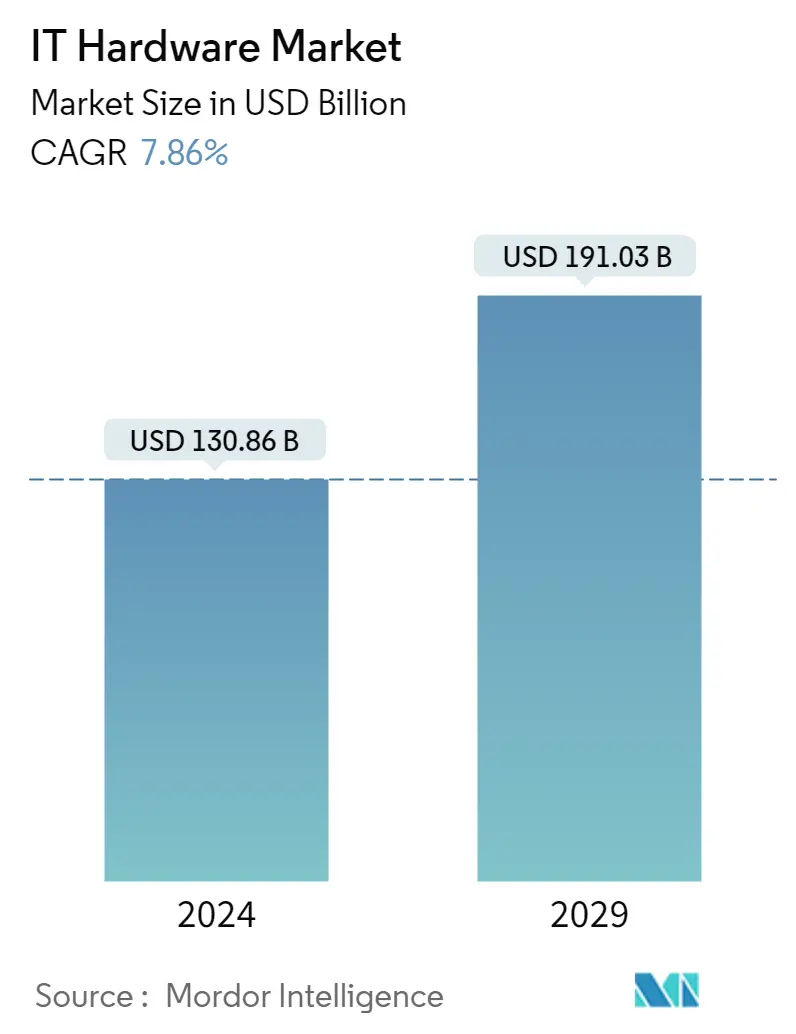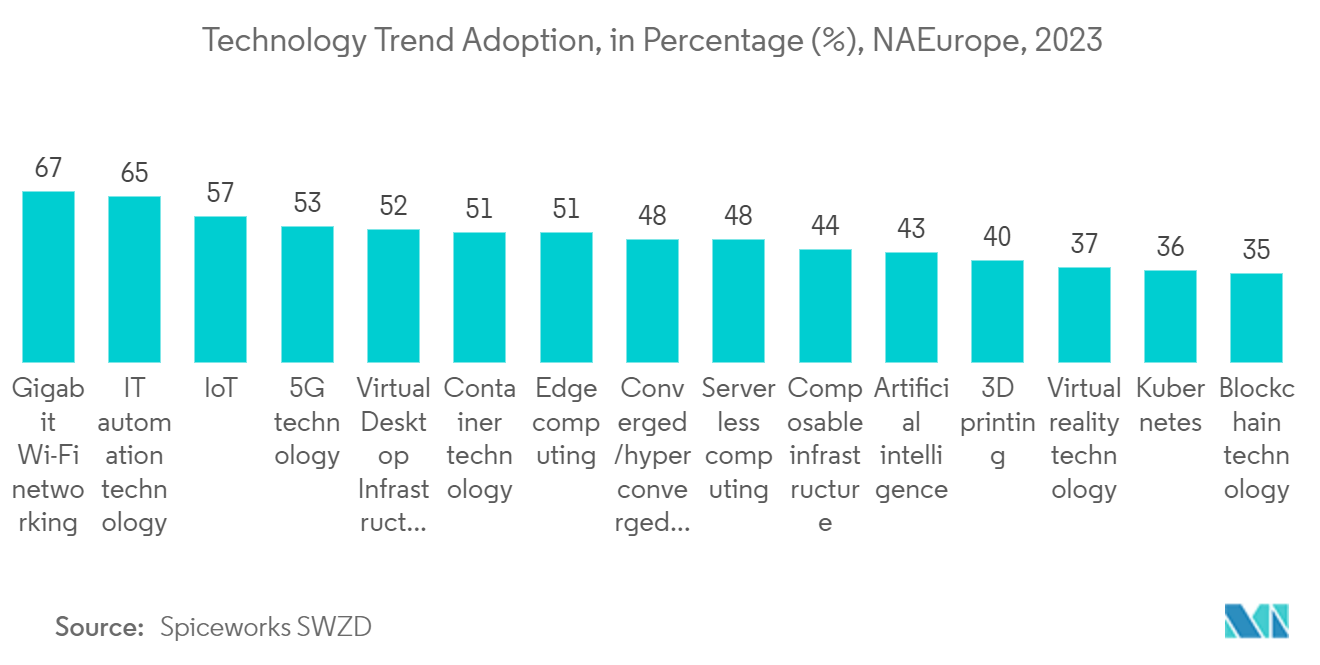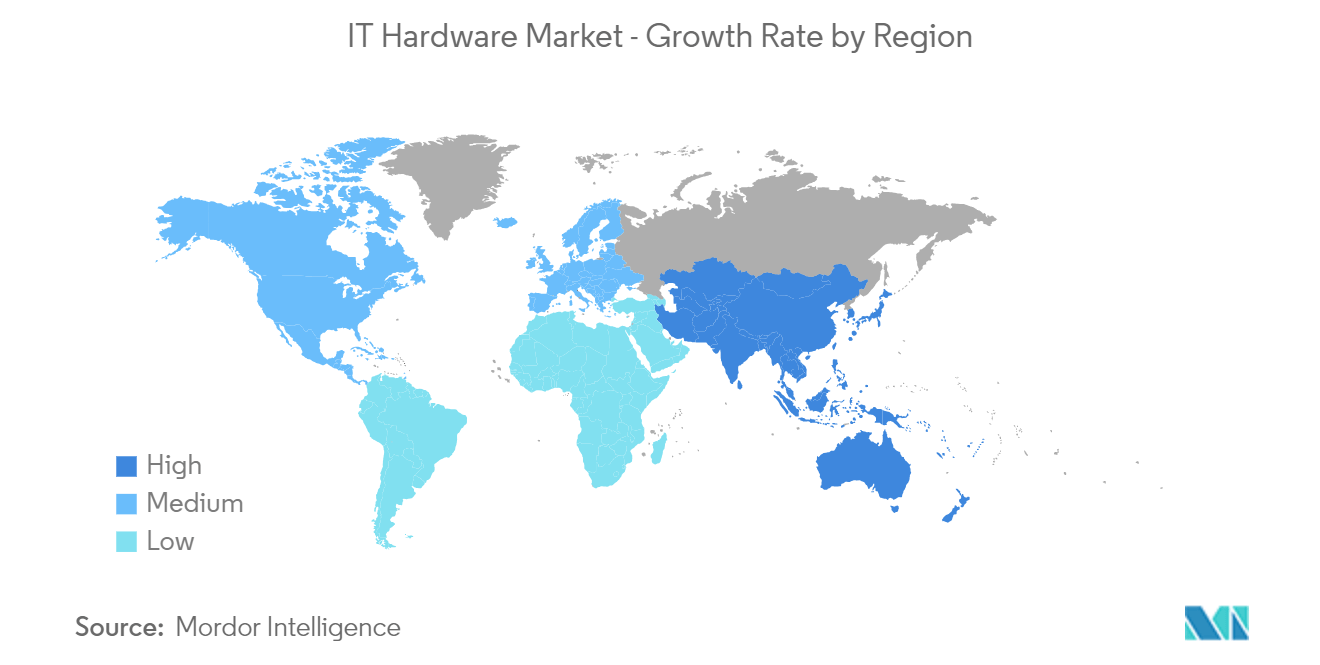IT Hardware Market Size

| Study Period | 2019 - 2029 |
| Market Size (2024) | USD 130.86 Billion |
| Market Size (2029) | USD 191.03 Billion |
| CAGR (2024 - 2029) | 7.86 % |
| Fastest Growing Market | Asia-Pacific |
| Largest Market | North America |
Major Players
*Disclaimer: Major Players sorted in no particular order |
IT Hardware Market Analysis
The IT Hardware Market size is estimated at USD 130.86 billion in 2024, and is expected to reach USD 191.03 billion by 2029, growing at a CAGR of 7.86% during the forecast period (2024-2029).
The IT hardware market refers to the global industry encompassing the production, distribution, and sale of computer hardware components and devices. IT hardware includes a wide range of products, such as personal computers, laptops, servers, storage devices, networking equipment, peripherals (such as keyboards and printers), and other electronic devices used for computing.
- Laptops and tablets have gained popularity due to their mobility and versatility. These devices are widely used for work, education, entertainment, and personal use. Manufacturers continually introduce new models with improved features like faster processors, better displays, longer battery life, and enhanced connectivity options.
- The rapid growth of the IT industry has been a significant driver for the IT hardware market. IT is crucial in various sectors, including business, healthcare, education, finance, entertainment, and government. As the industry continues to expand and evolve, the demand for IT hardware increases correspondingly.
- The increasing digitization of the public sector is a significant driver for the IT hardware market. Governments worldwide recognize the benefits of digital technologies and are implementing various initiatives to enhance their service delivery, improve efficiency, and provide better citizen-centric solutions.
- The rising concern regarding e-waste poses a restraint on the IT hardware market. E-waste refers to electronic waste generated from discarded or obsolete electronic devices, including IT hardware components. As technology evolves rapidly, the lifespan of IT hardware devices has become shorter, leading to a significant increase in e-waste volumes.
- The COVID-19 pandemic forced many organizations and educational institutions to adopt remote work and distance learning models. This led to a surge in demand for IT hardware devices like laptops, desktops, webcams, and accessories as individuals and businesses needed to equip themselves for remote work and learning environments.
IT Hardware Market Trends
Rapid Growth of the IT Industry is Expected to Drive the IT Hardware Market
- The expansion of the IT industry drives the need for advanced and efficient IT hardware solutions. This includes servers, storage devices, networking equipment, computer systems, and peripherals. As companies and organizations increasingly adopt digital transformation strategies, they require robust and scalable hardware infrastructure to handle the growing volumes of data, ensure seamless connectivity, and support their software applications.
- The proliferation of cloud computing and big data analytics has particularly contributed to the growth of the IT hardware market. Cloud service providers and enterprises require powerful servers, storage systems, and networking equipment to host and process vast amounts of data in real time. Additionally, the rise of artificial intelligence (AI), machine learning (ML), and Internet of Things (IoT) technologies further drive the demand for specialized hardware components optimized for these applications.
- According to Spiceworks, and SWZD, Gigabit Wi-Fi networking (67%) was the most popular information technology trend deployed or intended to be implemented in North American and European organizations, followed by IT automation technologies (65%).
- Moreover, the ongoing advancements in IT hardware, such as faster processors, increased storage capacities, improved networking technologies, and energy-efficient designs, continue to attract businesses seeking to enhance their IT infrastructure. The need for upgraded hardware to support emerging technologies like 5G networks, edge computing, and quantum computing also contributes to market growth.
- Overall, the rapid growth of the IT industry, fueled by technological advancements and increasing digitalization across sectors, creates a strong demand for IT hardware. This trend is expected to continue as organizations prioritize investments in infrastructure to stay competitive, improve operational efficiency, and harness the potential of emerging technologies.

Asia Pacific Expected to be the Fastest Growing Region
- The Asia Pacific region has a large population and a growing middle class, driving the demand for IT hardware products. The market size for IT hardware in the region is substantial and continues to grow due to urbanization, digitization, and increasing disposable incomes.
- Many global IT hardware manufacturers have established manufacturing facilities in China, Taiwan, and South Korea. These countries are major manufacturing hubs for IT hardware products, including components, devices, and peripherals. A robust manufacturing ecosystem in the region contributes to the availability and affordability of IT hardware.
- The Asia Pacific region has witnessed significant growth in internet penetration, driven by the increasing use of smartphones, affordable internet plans, and government initiatives to expand connectivity. The growing internet user base creates a strong demand for IT hardware devices such as smartphones, laptops, and tablets.
- The rise of e-commerce and digital services in the Asia Pacific region has profoundly impacted the IT hardware market. E-commerce platforms provide a convenient way for consumers to purchase IT hardware products, leading to increased sales. Moreover, the growth of digital services, cloud computing, and data centers drives the demand for IT hardware infrastructure.
- Mobile devices, particularly smartphones, have become an integral part of daily life in the Asia Pacific region. The demand for smartphones continues to grow, with consumers seeking advanced features and affordable options. Asia Pacific countries are among the largest consumers of smartphones globally, driving the demand for IT hardware components.

IT Hardware Industry Overview
IT Hardware Market is highly fragmented with the presence of major players like HP Inc., Samsung Electronics Co. Ltd., Intel Corporation, Dell Technologies Inc., and Acer Inc. Players in the market are adopting strategies such as partnerships and acquisitions to enhance their product offerings and gain sustainable competitive advantage.
- May 2023 - Samsung Electronics Co., Ltd. announced the global release of its 2023 Smart Monitor lineup. Samsung's new M8, M7, and M5 Smart Monitors Models Name M80C, M70C, and M50C, allow users to personalize their monitor to their style and demands when watching, playing, and working.
- October 2022 - Intel signed an agreement with original design manufacturer VVDN Technologies to design, develop, and manufacture Intel-based devices for telecom, networking, cloud, and 5G in India. VVDN, situated in Gurgaon, develops solutions for global consumers in 5G, networking and Wi-Fi, vision, Internet of Things, cloud, and applications. VVDN operates six manufacturing units in Manesar, near Gurugram, and intends to invest Rs 500 crore USD 60.5 Million over the next three years to increase production capacity with a new factory in Tamil Nadu.
IT Hardware Market Leaders
-
HP Inc.
-
Samsung Electronics Co. Ltd.
-
Intel Corporation
-
Dell Technologies Inc.
-
Acer Inc.
*Disclaimer: Major Players sorted in no particular order

IT Hardware Market News
- May 2023 - The IT hardware PLI 2.0 aims to increase India's output and presence in the global IT hardware/servers/laptop value chains. PLI 2.0 for IT hardware would catalyze India's USD300 billion electronics manufacturing ambition, a key component of its country's trillion-dollar digital economy aim.
- April 2023 - Samsung Electronics and AMD announced a multi-year cooperation renewal to bring many generations of high-performance, ultra-low-power AMD Radeon graphics solutions to an extended array of Samsung Exynos SoCs.
IT Hardware Market Report - Table of Contents
1. INTRODUCTION
- 1.1 Study Assumptions and Market Definition
- 1.2 Scope of the Study
2. RESEARCH METHODOLOGY
3. EXECUTIVE SUMMARY
4. MARKET INSIGHTS
- 4.1 Market Overview
-
4.2 Industry Attractiveness - Porter's Five Forces Analysis
- 4.2.1 Threat of New Entrants
- 4.2.2 Bargaining Power of Buyers/Consumers
- 4.2.3 Bargaining Power of Suppliers
- 4.2.4 Threat of Substitute Products
- 4.2.5 Intensity of Competitive Rivalry
- 4.3 Industry Value Chain Analysis
- 4.4 Assessment Of the Impact of COVID-19 on the Industry
5. MARKET DYNAMICS
-
5.1 Market Drivers
- 5.1.1 Rapid Growth of the IT Industry
- 5.1.2 Increasing Digitization of the Public Sector
-
5.2 Market Restraints
- 5.2.1 Rising Concern Regarding e-Waste
6. MARKET SEGMENTATION
-
6.1 By Type
- 6.1.1 PC & Workstation
- 6.1.2 Networking Hardware - Routers, Hubs, Switches
- 6.1.3 Server Market
- 6.1.4 Storage Devices
-
6.2 By Geography
- 6.2.1 North America
- 6.2.2 Europe
- 6.2.3 Asia Pacific
- 6.2.4 Latin America
- 6.2.5 Middle East and Africa
7. COMPETITIVE LANDSCAPE
-
7.1 Company Profiles
- 7.1.1 HP Inc.
- 7.1.2 Samsung Electronics Co. Ltd.
- 7.1.3 Intel Corporation
- 7.1.4 Dell Technologies Inc.
- 7.1.5 Acer Inc.
- 7.1.6 Lenovo Group Ltd.
- 7.1.7 Apple Inc.
- 7.1.8 Sony Corporation
- 7.1.9 Panasonic Corporation
- 7.1.10 Cisco Systems Inc.
- *List Not Exhaustive
8. INVESTMENT ANALYSIS
9. FUTIRE OF THE MARKET
** Subject To AvailablityIT Hardware Industry Segmentation
Hardware (H/W), in the context of technology, refers to the physical elements that make up a computer or electronic system and everything else involved that is physically tangible.
The IT Hardware Market is Segmented By Type (PC & Workstations, Networking Hardware - Routers, Hubs, Switches, Server, Storage Devices), by Geography (North America, Europe, Asia Pacific, Latin America, Middle East and Africa). The market sizes and forecasts are provided in terms of value in USD billion for all the above segments.
| By Type | PC & Workstation |
| Networking Hardware - Routers, Hubs, Switches | |
| Server Market | |
| Storage Devices | |
| By Geography | North America |
| Europe | |
| Asia Pacific | |
| Latin America | |
| Middle East and Africa |
IT Hardware Market Research FAQs
How big is the Global IT Hardware Market?
The Global IT Hardware Market size is expected to reach USD 130.86 billion in 2024 and grow at a CAGR of 7.86% to reach USD 191.03 billion by 2029.
What is the current Global IT Hardware Market size?
In 2024, the Global IT Hardware Market size is expected to reach USD 130.86 billion.
Who are the key players in Global IT Hardware Market?
HP Inc., Samsung Electronics Co. Ltd., Intel Corporation, Dell Technologies Inc. and Acer Inc. are the major companies operating in the Global IT Hardware Market.
Which is the fastest growing region in Global IT Hardware Market?
Asia-Pacific is estimated to grow at the highest CAGR over the forecast period (2024-2029).
Which region has the biggest share in Global IT Hardware Market?
In 2024, the North America accounts for the largest market share in Global IT Hardware Market.
What years does this Global IT Hardware Market cover, and what was the market size in 2023?
In 2023, the Global IT Hardware Market size was estimated at USD 121.32 billion. The report covers the Global IT Hardware Market historical market size for years: 2019, 2020, 2021, 2022 and 2023. The report also forecasts the Global IT Hardware Market size for years: 2024, 2025, 2026, 2027, 2028 and 2029.
IT Hardware Industry Report
Statistics for the 2024 IT Hardware market share, size and revenue growth rate, created by Mordor Intelligence™ Industry Reports. IT Hardware analysis includes a market forecast outlook to 2029 and historical overview. Get a sample of this industry analysis as a free report PDF download.



